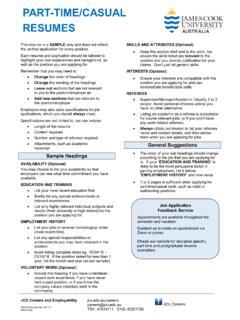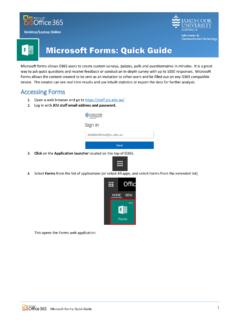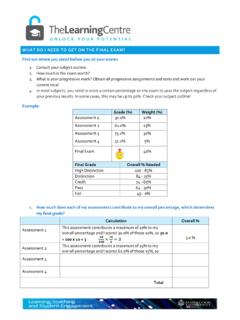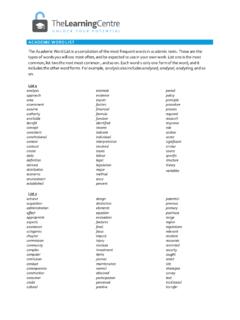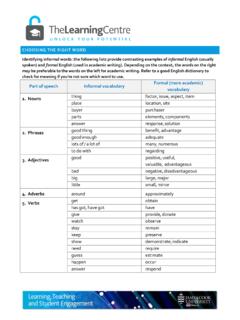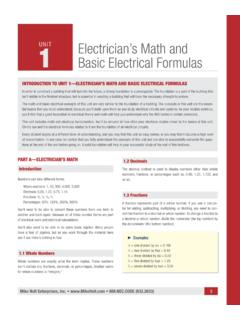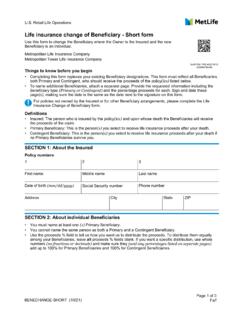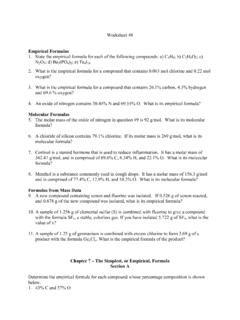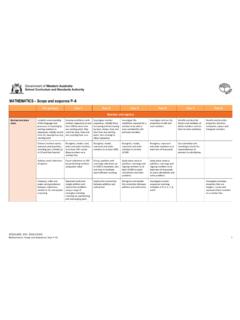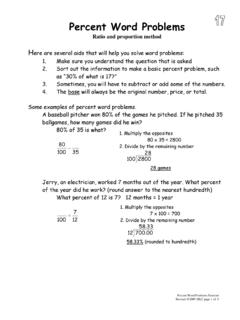Transcription of Maths Refresher Workbook 1 - James Cook University
1 Maths Refresher Workbook 1 This booklet will help to refresh your understanding of: number decimals, fractions and percentages exponents and roots Page 1 of 40 Maths Refresher Booklet 1 Contents 1. Introduction: number .. 2 2. Rounding and Estimating .. 5 3. Order of 6 4. Naming Fractions .. 7 5. Equivalent Fractions .. 8 6. Converting Mixed Numbers to Improper Fractions .. 9 7. Converting Improper Fractions to Mixed Numbers .. 10 8. Converting Decimals into 11 9. Converting Fractions into Decimals.
2 12 10. Fraction Addition and Subtraction .. 12 11. Fraction Multiplication and Division .. 14 12. Percentage .. 16 12 (continued). Activity: What do I need to get on the final exam??? .. 17 13. Ratio .. 19 14. Averages .. 22 15. Powers .. 23 16. Power Operations .. 24 17. Roots .. 25 18. Root 26 19. Fraction Powers/Exponents .. 27 20. Logarithms .. 28 21. Unit Conversions .. 29 22. ANSWERS .. 34 23. Glossary .. 38 24. Helpful websites .. 40 Page 2 of 40 1. Introduction: number Mathematics is the science of patterns and relationships related to quantity.
3 Listed below are some of the many relationships you may have come across: o Every number is related to every other number in a number relationship. For example, 8 is 2 less than 10; made up of 4 and 4 (or 3 and 5); and is 10 times ; is the square root of 64; and so o number relationships are the foundation of strategies that help us remember number facts. For instance, knowing 4 + 4 = 8 allows one to quickly work out 4 + 5 = 9 (one more than 8); If one knows that 2 x 5 = 10, then 4 x 5 and 8 x 5 can easily be calculated (double 2 is 4 and so double 10 is 20; then double 4 is 8 and so double 20 is 40).
4 O Each digit in a written numeral has a place value which shows its relationship to 1 . For example, in the value of the 2 is 20 ones, while the value of the 5 is only five-hundredths of one. Understanding place value is critical to working with numbers. Mathematics is considered a universal language; however, words in English can often have more than one meaning which is why we sometimes find it difficult to translate from English to mathematical expressions. Arithmetic is a study of numbers and their manipulation.
5 The most commonly used numbers in arithmetic are integers, which are positive and negative whole numbers including zero. For example: -6,-5,-4,-3,-2,-1,0,1,2,3,4,5,6. Decimal fractions are not integers because they are parts of a whole , for instance, is 6 tenths of a whole . The symbols we use between the numbers to indicate a task or relationships are the operators, and the table below provides a list of common operators. You may recall the phrase, doing an operation. Symbol Meaning + Add, Plus, Addition, Sum Minus, Take away, Subtract, Difference Times, Multiply, Product, Divide, Quotient Plus or Minus |a| Absolute Value (ignore ve sign) = Equal Not Equal < Less than > Greater than Much Less than Much More than Approximately equal to Less than or equal Greater than or equal Page 3 of 40 Example: 1.
6 12 6=6 18. 12 6 12+6 2. | 6|=6 3. 13 4. 12 7 5. Speed of light speed of sound 1. Your Turn: Are the following statements true? a) 32 4 8 b) 7 >6 c) 4 4 d) |5|=5 e) + = Integers whole numbers are integers; there are positive and negative integers. Positive integers are 1, 2, 3, 4, The negative integers are .. -5, -4, -3, -2, -1 (the dots before or after the sequence indicate that there are more numbers in this sequence that continue indefinitely). Here are some more terms for you: An equation implies that what is on either side of the = sign balances.
7 The sum of two numbers implies two numbers are added together. The sum of 4 and 8 is 12; 4 +8 =12 The difference of two numbers implies that the second number is subtracted from the first number . The difference between 9 and three is 6; 9 3 =6 The product of two numbers implies that two numbers are multiplied together. The product of 3 and 4 is 12; 3 4 =12 The quotient of two numbers implies that the first number is divided by the second. The quotient of 20 and 4 is 5; 204 = 5 or 20 4 =5 Rational number : The term rational derives from the word ratio.
8 Hence, a rational number can be a described by a ratio of integers or as a fraction. For example, 34 0. 75 are both rational numbers. Irrational number : A number that cannot be written as a simple fraction or as a decimal fraction. If the number goes on forever without terminating, and without repeating, then it is an irrational number . For example, is a recurring decimal that does not repeat: Therefore, is an irrational number . Directed Numbers (negative and positive integers) Directed numbers are numbers that have positive (+) and ( ) signs signifying their direction.
9 Note that when using the calculator, we use the ( ) key rather than the subtraction key, and each negative number may need to be br acketted, for instance, ( 3) + (+3) = 0. When naming directed numbers we use the terms negative and positive numbers; avoiding the terms plus and minus unless you are indicating that an operation is taking place of plus for addition and minus for subtraction. So, ( 3)+3 =0 reads negative 3 plus positive 3 equals zero To use a graphic symbol we can display ( 5) and (+5) as.
10 5 0 +5 This graphic symbol is known as a number line and can be used to show how and why operations work. Addition: To add a number we move to the right: 2 +4 =6 0 +2 2 +4 6 Page 4 of 40 Here we are adding a positive number beginning at a negative number . Thus if we begin at zero we move in a negative direction to get to -2, and then in a positive direction of 6, and so we reach +4: ( 2) + (+6) = 4 -2 0 +6 4 Your Turn: Represent 3 + 5 = 0 Subtraction: To subtract a positive number we move that number of places to the left.




